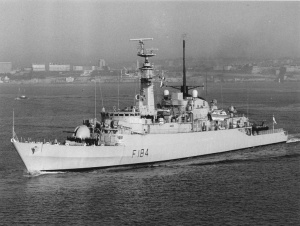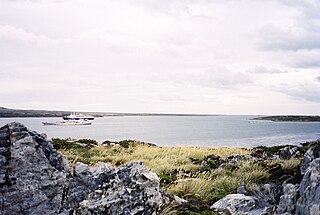The Falkland Islands currently has three primary means of transport - road, sea and air. However, in 1946, when Sir Miles Clifford arrived as governor, there were no air services, no roads outside Stanley and an indifferent sea service. Sir Miles was instrumental in starting the Falkland Islands Government Air Service in December 1948. The inaugural flight involved a mercy flight from North Arm Settlement to Stanley to bring a girl with peritonitis to life-saving medical help in Stanley. There is now an international airport, a domestic airport, a number of airstrips, a growing road network and a much-improved ferry service between the two main islands.

HMS Ardent was a Royal Navy Type 21 frigate. Built by Yarrow Shipbuilders Ltd, Glasgow, Scotland. She was completed with Exocet launchers in 'B' position. Ardent took part in the Falklands War, where she was sunk by Argentine aircraft in the Falkland Sound on 21 May 1982.

The Shag Rocks are six small islets, as opposed to islands, in the westernmost extreme of South Georgia, 240 km (150 mi) west of the main island of South Georgia and 1,000 km (620 mi) off the Falkland Islands. The Shag Rocks are located at 53°32′51″S42°01′12″W. 16 kilometres (9.9 mi) further southeast is Black Rock, which is located at 53°38′06″S41°46′30″W.

West Falkland is the second largest of the Falkland Islands in the South Atlantic. It is a hilly island, separated from East Falkland by the Falkland Sound. Its area is 4,532 square kilometres, 37% of the total area of the islands. Its coastline is 1,258.7 kilometres long.

Weddell Island is one of the Falkland Islands in the South Atlantic, lying off the southwest extremity of West Falkland. It is situated 1,545 km (960 mi) west-northwest of South Georgia Island, 1,165 km (724 mi) north of Livingston Island, 606 km (377 mi) northeast of Cape Horn, 358 km (222 mi) northeast of Isla de los Estados, and 510 km (320 mi) east of the Atlantic entrance to Magellan Strait.

Carcass Island is the largest of the West Point Island Group of the Falkland Islands.

The Falkland Sound is a sea strait in the Falkland Islands. Running southwest-northeast, it separates West and East Falkland.

The Camp is the term used in the Falkland Islands to refer to any part of the islands outside the islands' only significant town, Stanley, and often the large RAF base at Mount Pleasant. It is derived from the Spanish word campo, for "countryside".

Port San Carlos is located on the northern bank of the inlet known as Port San Carlos, off San Carlos Water on the Western coast of East Falkland, in the Falkland Islands. It is sometimes nicknamed "KC" after former owner Keith Cameron.

Port Egmont was the first British settlement in the Falkland Islands, on Saunders Island off West Falkland, and is named after the Earl of Egmont.

San Carlos Water is a bay/fjord on the west coast of East Falkland, facing onto the Falkland Sound.
Grantham Sound is a bay on East Falkland, Falkland Islands, which opens out into the Falkland Sound. At its landward end, it narrows and becomes Brenton Loch. Mount Usborne overlooks it.

Port William is a large inlet on the east coast of East Falkland island. A strait called "the Narrows" leads into Stanley Harbour.

Salvador Water or Port Salvador is a bay/inlet on the northeast coast of East Falkland, the largest of the Falkland Islands. It has an intricate shoreline, but could be described as being shaped like an "M".

Mare Harbour, known colloquially as East Cove Port, is a small settlement on East Falkland, on Choiseul Sound. It is mostly used as a port facility and depot for RAF Mount Pleasant, as well as a deepwater port used by the Royal Navy ships patrolling the South Atlantic and Antarctica, which means that the main harbour of the islands, Stanley Harbour tends to deal with commercial transport.

Shingle Cove is a small, sheltered cove in the north-west corner of Iceberg Bay, several kilometres east of Cape Hansen, on the south coast of Coronation Island, in the South Orkney Islands of Antarctica. The nearest research station is the British Signy, about 1.5 km south-west of Cape Hansen.
On 10 June 1982, in the closing days of the Falklands War, Many Branch Point, a ridge near Port Howard in West Falkland, was the site of a minor skirmish between the Argentine and British Armed Forces. The engagement ended with the death of the SAS patrol commander, Captain Gavin Hamilton. The action was the only ground engagement of the British and Argentine forces on West Falkland during the conflict.














